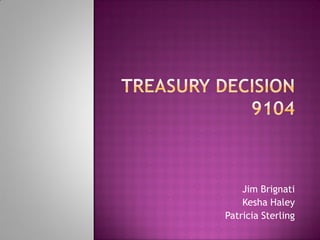Business Tax Strategies - Treasury Decision 9104
- 1. Jim Brignati Kesha Haley Patricia Sterling
- 2. ’é× IRS eliminated discovery test ’é× Replaced with process of experimentation
- 3. ’é× Researchis undertaken to eliminate uncertainty. ’é× Research does not have to exceed, expand, or refine common knowledge of a profession. ’é× Research does not require that the taxpayer succeed. ’é×A patent is conclusive evidence that the taxpayer has discovered something technological in nature.
- 4. ’é× Musthave fundamentally relied on the principles of physical or biological sciences, engineering, or computer science. ’é× Theprocess of experimentation is designed to evaluate one or more alternatives. ’é× Substantially all of the activities of which constitute elements of a process of experimentation related to a new or improved function, performance, or reliability or quality
- 5. ’é× Concern about application of shrinking back rule ’éĪ All expenses may not qualify. ’é× Finalregulations provide clarification that the rule is not intended to exclude qualified expenditures from credit, but rather is intended to ensure that expenses attributable to qualified research activities are eligible to research credit for purposes of Section 41.
- 6. ’é× Taxpayers should carefully review research activities that might otherwise fall within certain exclusions to ensure that only eligible activities are being included in their credit computations.






